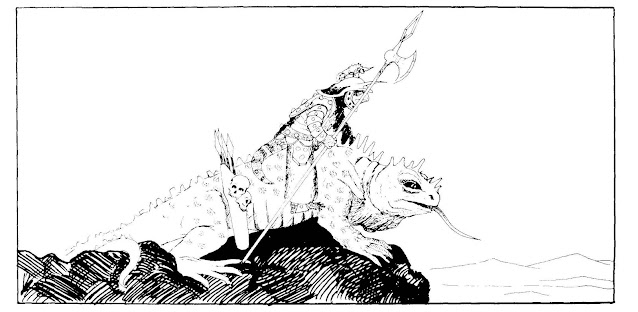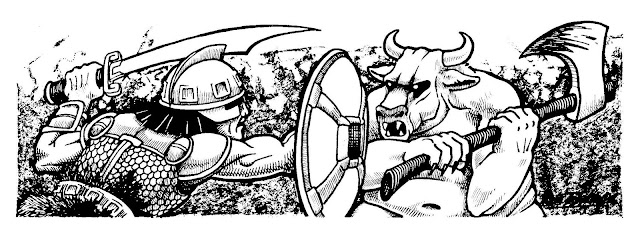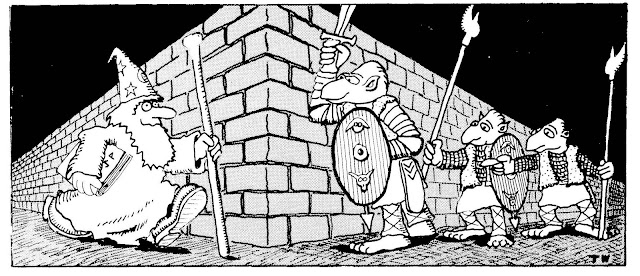The Dungeons and Dragons Basic Set, released by TSR in 1977, was the first time a table top role playing game tried to break into the mainstream. Although role playing was already a few years old at this point, it was not an approachable game for the novice even by the standards of its day. Role Playing had evolved from wargaming and was still somewhat confined to that crowd after Original Dungeons & Dragons had been released. One admirer of the D&D game was a physician and neurologist named John Eric Holmes. He approached TSR and offered to consolidate the existing ruleset into something more approachable for new and younger players. Gary Gygax accepted his assistance, as Gygax was developing Advanced Dungeons and Dragons in order to move away from the unstructured nature of OD&D but realized the benefit of having a less complicated game to introduce new players into the concept of role playing games.
Holmes compiled a manuscript which turned into a 48-page booklet, which was put in a colorful box with a module or supplementary dungeon building material and a set of polyhedron dice which was released in 1977 as the Dungeons and Dragons Basic Set. Intended to be only an introductory product to help players understand how to play and run an RPG, it proved to be very popular and spawned many successors. For several years it was one of TSR's most popular products, selling upwards of 12,000 copies per month by 1980. But is it playable today when those successors are as easy to find and buy? Let's take a look on how Holmes' distilled OD&D and presented it as a game in comparison with the later versions of the Basic Set.
I have already discussed the successor to Holmes' Basic set, the celebrated 1981 Tom Moldvay Basic set. Moldvay was a fairly substantial revision of the rules as presented in Holmes Basic, but the rules found in Moldvay would persist almost untouched for fifteen years, from Frank Mentzer's Basic Set to Aaron Allston's Rules Cyclopedia to the Black Box set. Similarly, the Dave Cook & Steve Marsh Expert Set, which was released contemporaneously with Moldvay Basic, would see very few changes in later products, as would Mentzer's Companion Rules and Master Rules.
Overview of the Holmes Basic Set
 |
| Holmes Basic Illustration by David C. Sutherland III |
The Holmes Basic Set was sold from early 1977 through 1980. It was sold as both a box set and the Rulebook was sold as a standalone product for less money. In the boxset the Rulebook would come with different materials depending on when you bought it. Early Basic Sets came with Dungeon Geomprphs Set One, Basic Dungeon and Monster & Treasure Assortments Set One, Levels One-Three. These items, also available separately, helped you design a dungeon and populate it, but left the narrative links to the owner's imagination. Middle Basic Sets ditched the Geomorphs and Assortments for an adventure module, B1: In Search of the Unknown. This module took a different approach, it gave you the floor plan of a dungeon and the narrative links, but had you populate each room with monsters and treasures. Late Basic Sets switched out B1 for one of the most highly regarded modules of all time, Gary Gygax's B2: The Keep on the Borderlands. B2 was a traditional adventure module that laid everything out, the monsters, the maps, the tricks, the treasure and a home base (the keep) where the party could use in between forays to the Caves of Chaos.
One other singular feature of Holmes Basic is that sometimes the set came with a set of five colored and inked polyhedral dice (d4, d6, d8, d12, d20 only the five platonic solids were included, d10s are not platonic solids), sometimes it came with six monochromatic and uninked dice (adding a d10) and a crayon to fill in the numbers on the dice, and at other times it came with a cardboard sheet of dice "chits" intended to simulate rolling a dice by drawing a chit out of a bag or a cup unseen. Basic D&D and AD&D were so popular that the games caused a shortage of polyhedral dice, which were previously used almost exclusively by educational customers and the makers were unable to cope with a huge increase in demand. The copies with dice chits came with coupons to buy a set of polyhedral dice for a small amount of money when dice were available.
Having got our overview out of the way, let's turn our attention to some of the major differences between Holmes Basic and later versions of Classic D&D Basic. This will not be a comprehensive list of every difference between Holmes Basic and Moldvay Basic, but should give enough description of some of the basic differences for players experienced with Classic D&D to understand the uniqueness of Holmes Basic.
Character Ability Scores
The first thing we see off the bat in Holmes Basic is that Character ability scores give very little in the way of modifiers compared to Moldvay Basic or AD&D. There are no modifiers for a high or low Strength or Wisdom score and Constitution and Dexterity modifiers are more limited. Intelligence has no affect on language learning ability. A high Charisma score is of somewhat indefinite benefit, although it could keep you from being eaten by a dragon or turned into a frog by a witch. The main benefit of a high ability score is its ability to boost or reduce your earned experience if your character's prime requisite score is high or low for that character class. This was essentially retained in Moldvay as was the ability to lower some ability scores to raise others.
In the Basic Set and for the remainder of the "Classic D&D" era, the rules instructed you, regardless of author, to roll 3d6 for each score. There was no roll 4d6 and drop the lowest die or roll 3d6 twelve times and assign the best six to scores. The bell curve for a 3d6 gives average scores of 9-12 most of the time, which correspond to no bonuses for either Holmes or Moldvay prior to ability score adjustment. Most classes will see some survival benefit by raising one or two ability scores in Moldvay compared to Holmes, but super-powered characters are the province of the Expert, Companion and Master Sets. Raising ability scores in Classic D&D or AD&D is not easy, automatic increases to ability scores were introduced in 3rd Edition. Holmes Basic was intended to allow for levels 1-3 and then it was onto AD&D, so Holmes can be forgiven for a lack of foresight into how ability scores might be used to make characters more powerful.
Classes & Races
 |
| Holmes Basic Illustration by David C. Sutherland III |
While all Basic Sets treat Dwarves and Halflings as Fighting Men with special abilities (and the occasional drawback such as using a d6 for hit die for Halflings instead of a d8 for Fighting Men and Dwarves), the Elf class is treated a little differently in Holmes vs. Moldvay. In Holmes an Elf is a multi-classed fighting man and Magic-User, with experience points earned being split evenly for the requirements of the fighting man and the Magic-User. Moldvay simplifies the Elf as a class with both fighting man and Magic-User abilities and higher experience point requirements for leveling up. A Holmes Elf requires 4500 XP to reach level 2 (in both classes) while a Moldvay Elf requires only 4000 XP, and similarly 9000 vs 8000 for level 3. Fighting Men progress faster than Magic-Users, so an Elf can enjoy the benefit of a level 2 in his Fighting Man class while still being a level 1 Magic-User. When an Elf is supposed to roll for his hit point increase due to leveling up is not explained in Holmes Basic and it is not obvious because the level progression in the Elf's two classes is not synchronized. Also, the saving throws for Elves are not strictly defined. Moldvay presumably saw this as needlessly complex and simplified the Elf into a unique class.
Alignment
Unique to Holmes Basic is a five alignment system. Character alignment had been defined into three alignments in OD&D, law, neutrality and chaos. Law was good, chaos was evil and neutral was in-between. By the time of the Supplements, there was some nuance in that "lawful" creatures were not always necessarily "good" and some could be "evil". While the Basic Set was in development, Gygax was developing a two-axis alignment system for AD&D combining "law, neutrality and chaos" with "good, neutrality and evil" to obtain nine alignments through the various combinations. This duality had been developing since at least Supplement III: Eldrich Wizardry . Gygax had developed a predecessor to the nine alignment system and used it in Holmes Basic to give five alignments, lawful good, lawful evil, neutral, chaotic good & chaotic evil. Neutral was given the short shrift, so there is no lawful neutral, neutral good, neutral evil or chaotic neutral in Holmes Basic. Holmes also specifies that certain unintelligent monsters have no alignment and attack based on instinct or hunger. Moldvay would deem these monsters and animals to have a neutral alignment.
Unfortunately Holmes does not give much of a description about the specific combinations of law/chaos and good/evil. How a lawful evil character differs from a chaotic evil character is not explained and these alignments good counterparts are barely touched upon. Moldvay ditched the good/evil axis and restored the three alignment system which remained standard for the rest of Classic D&D. Monsters which were classified as "lawful evil" in Holmes became "chaotic" in Moldvay (when contained in both) or the higher level sets. Moldvay and Mentzer pretty much equated "chaotic" with "evil", but while some nuance in language suggest that was not always the case. Allston's Rules Cyclopedia was the first text to allow explicitly for a "chaotic good"-like vision for the chaotic alignment.
Equipment and Spells
 |
| Holmes Basic Illustration by D. A. Trampier |
Holmes has a larger equipment list than Moldvay, with weapons like Flail and Morning Star, Horses & Mules, Rafts. Wagons and Small Boats. The Cook/Marsh Expert Set supplied most of what was in Holmes for games started with Moldvay Basic because the Expert Set was more geared toward wilderness adventures while Moldvay Basic was more focused on dungeoneering.
Holmes gives 14-18 spells for Magic-User Spell Level 1, Level 2 & Level 3. Moldvay only gives 14-12 spells for Magic-User Spell Level 1 and Level 2 and omits Level 3 Spells entirely. Both Holmes and Moldvay give 8 spells for Cleric Spell Level 1, but Homes gives spells for Spell Level 2 while Moldvay does not.
Holmes has a unique way for Magic-Users to learn spells, based on their Intelligence score, compared to the later revisions of the Classic D&D Rules. In Holmes, the Magic-User or Elf's intelligence dictates how many spells they can know at a minimum and maximum for each spell level and the chance to know each spell. If this sounds like AD&D, well essentially it is but it was taken from the Supplement I: Greyhawk. Holmes allows a Magic-User to learn up to the the maximum number of spells permitted by his Intelligence for each Spell Level. For each spell the character can learn, he must roll percentile to see whether he can learn that spell. Moldvay lets the Dungeon Master give one spell to start and Mentzer gives Read Magic plus one other spell, then add a spell for each level.
Encumbrance
Encumbrance in Holmes Basic is pretty basic. The movement rate is affected by being fully armored or heavily loaded (600 gold pieces) or both. Moldvay gives similarly vague categories of movement but also allows you to calculate your movement rate by "coin weight." Coin weight (ditched by 2nd Edition with little nostalgia) is 10 coins = 1 pound. Holmes' rules for encumbrance work better than Moldvay's basic rule, but the coin weight is a better way to calculate encumbrance overall.
Monsters
Holmes offers a wide variety of monsters, including some rather powerful monsters (Black Puddings, Djinni, Giants, Purple Worms and Vampires) that can easily lead to a TPK for a level three party. Moldvay offers some more sane monster options for lower level encounters, including more animal and giant insect types. Of course monster statistics for Dragons are always included, even though all but the youngest and weakest dragons will likely turn a low level party into a quick meal.
Combat
 |
| Holmes Basic Illustration by Tom Wham |
The lack of variable weapon damage makes the Fighting Man class rather less attractive than in other editions of D&D. A Magic-User or Thief has the same ability to hit and can cause the same amount of damage as a Fighting Man in Holmes Basic. A Cleric can cause the same damage, use the same armor, turn undead and eventually cast spells with only 1 less HP per level on average. While this lack of distinctiveness would change significantly in the Expert Set, Holmes Basic was not meant to have an Expert Set but allow players to graduate to AD&D and its significantly different rules set (or move onto OD&D.)
Moldvay Basic defaulted to 1d6 damage per player hit, regardless of weapon, but also had an optional variable weapon damage table for each available weapon. This gave more variety to combat and made the Fighter a more formidable class. Two-handed weapons were not without their drawbacks, (no shield and always lose initiative) but they could usually inflict more damage. It is suggested to use the man-sized variable weapons damage table from Supplement I: Greyhawk, which would have been the only table available at the time Holmes Basic was being compiled, and all weapons attack once per round. This is another good solution, but some solution must be had for this horrible rule.
Initiative was given a unique treatment in Holmes Basic. The opponent with the higher Dexerity score attacks first in a round, unless the Dexterity scores are within 2 points of each other, then the opponent who rolls higher on a d6 goes first. As monsters were not given Dexterity scores in Holmes Basic, the rules advise the Dungeon Master to roll up the monsters' Dexterity scores on the spot.
In Moldvay Basic, each party rolls 1d6 for initiative and the party which rolls higher goes first. As this can be rather a bit unbalanced as the attacking party might wipe out the defenders in the first round, combatants can be paired and individual initiative can be rolled for each set of opponents. In this case, a character's Dexterity can improve or hinder his ability to gain the initiative first. Monsters do not have Dexterity scores, but the DM can add bonuses for extremely quick monsters.
Is Holmes Basic Playable?
 |
| A Sample Character Generated Using Holmes Basic |
Holmes Basic represents the first expression of the rules that was intended for the general public (non-wargamers) and was a complete system requiring nothing else to play. OD&D referenced external products (Chainmail, Outdoor Survival) and using the Supplements and reading articles in The Strategic Review and The Dragon magazines was generally recommended. AD&D was released over a three year period beginning in 1977 and needed something of a salad bar of TSR material to use (some people used Holmes Basic to fill in some gaps) until completed in 1979. AD&D was not the most beginner-friendly version of the game, so Holmes Basic did its best to fill the gap.
One can view Holmes Basic as a bridge between OD&D and Classic D&D as formalized by B/X, BECMI and the Rules Cyclopedia. Even though Holmes Basic looks markedly different than B/X and later iterations on the surface, it really is essentially a "rules lighter" version of Classic D&D. And if you wanted to go on to AD&D as the book repeatedly suggests, you can convert your old characters from D&D to AD&D with a few adjustments to hit points (+1 hp/level for everyone but a Magic User is a good idea) and a few other things.
My suggestion, if you wish to see whether Holmes Basic is right for you, is to try the sample dungeon contained in it, the "Tower of Zenopus." The encounters are not too difficult for a party of 3-5 adventurers. You might find the less rigid, more OD&D like Holmes Basic preferable to the significant changes of Classic D&D and OD&D.
Holmes Basic still has a following these days, inspiring at least one modern OSR-style clone called BLUEHOLME. There are also fan-based extensions of Holmes Basic such as The Holmes Companion which allow characters to progress to the 9th level. There is also a tremendous amount of information and support material for Holmes Basic at Zenopus Archives. Strangely, Holmes Basic cannot be purchased as a pdf or be printed on demand but can be found without too much trouble.


No comments:
Post a Comment